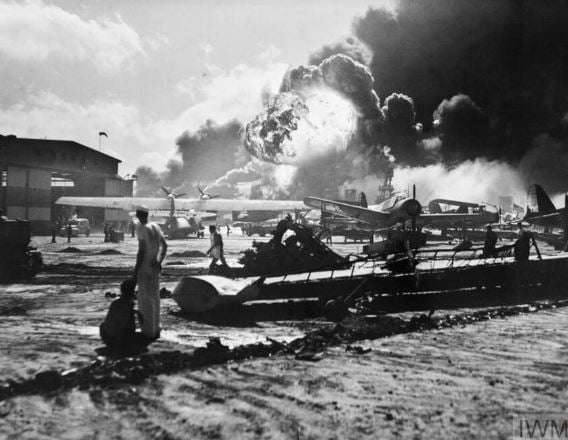The surprise attack came on a clear, bright day, on the morning of December 7, 1941, at 7:48am local time, 177 aircraft of the Imperial Japanese Navy attacked the United States Naval base at Pearl Harbor on the island of Oahu, Hawaii. Their intention was to destroy and damage as much of the US Pacific Fleet as possible, before it could respond to Japanese operations taking place on the same day against British, Dutch and US territories in southeast Asia.
The gleam of hope and possibility lingered as U.S. sailors and civilians were hard at work at the Hawaiian Naval Base, Pear Harbor. The clear, bright day disappeared within seconds, lost in the coal-black smoke of destruction from bombs dropped out of Japanese warplanes. As that moment stretched into a day, the United States became a nation at war.
The attack on Pearl Harbor left both sailors and civilians injured and killed.
A well-placed bomb blew the USS Arizona in half and sank her almost immediately. The USS Arizona exploded after the bomb hit its gunpowder stores, sinking the ship and killing its crew.

1,177 U.S. Navy sailors and Marines died aboard the USS Arizona during the attack on Pearl Harbor, and more than 900 remains are entombed within the ship.
Nobody knows how many Pearl Harbor survivors are still alive. Only two crewmen remain from the battleship USS Arizona, which has become the iconic symbol of that day.
The USS Arizona remains lay where she was sunk, straddled by a memorial that more than 2 million people visit each year. She is easily visible below the surface of the water, and she leaks more than two quarts of oil each day. The men who will never leave her will forever be a reminder of war’s terrible cost.
For generations of Americans, Dec. 7, 1941, is seared into our souls. 2,403 service members and civilians lost their lives 82 years ago at Pearl Harbor.
Across the country, communities watched young men leaving to fight in far-distant battlefields and oceans. For those left behind, the war years sparked an immediate upheaval in the social and economic landscape of the United States.
Many major shifts in American life can be traced back to the events of World War II.
The scars left on the United States from the attack on Pearl Harbor, which claimed so many lives, have had some healing. It would be six decades before this nation would experience anything comparable to Pearl Harbor; on Sept. 11, 2001, we bore another of war’s terrible costs.
Only a handful of those who served during World War II are still alive today. As a nation, however, we must never forget how quickly war’s destruction and turmoil can descend or how lasting the changes can be. And we must still mourn war’s terrible cost and honor the sacrifice of those who are lost.
Molly K Ottman Executive Editor/Journalist for Mountain Daily Star

